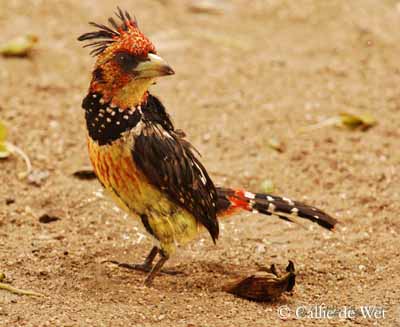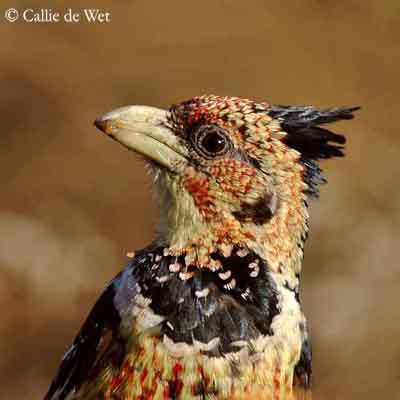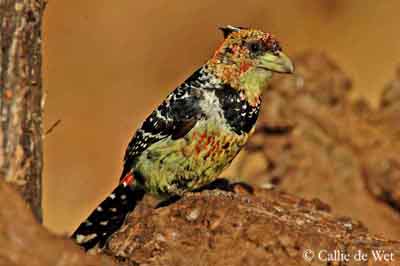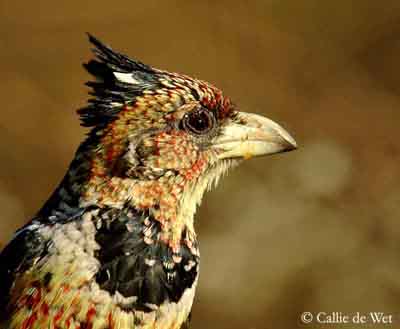
Crested Barbet
Trachyphonus vaillantii
Piciforme Order – Lybiidae Family
BIOMETRICS:
Length: 23 to 24 cm; Weight: 70 gr
DESCRIPTION:
Crested Barbet has a beautiful colourful plumage. Upperparts, back and wings, are black with white specks and crescents. We can see a broad black band on the rear neck. Tail is black barred with white, with white terminal edge. Rump is red.
Underparts are yellow. Upper breast shows a broad black band, finely spotted with white, and bordered with white, contrasting with the lower yellow breast, streaked with red. Belly is yellow.

Crested Barbet has colourful head, with black crest. Head is yellow, and we can see fine red scaling. Face is mostly red. Chin is yellow.
Short bill is strong and pale yellow. Eyes are reddish-brown, with olive-green bare skin as an eye ring. Legs and feet are greenish-grey.
Female is slightly duller than male.

VOICE: SOUNDS BY XENO-CANTO
Crested Barbet’s common call is a long trill “di-di-di” uttered during 30 seconds and sometimes up to five minutes. It is a very vocal bird and this trill may continue for long periods. It usually calls from an exposed branch.
Both mates sometimes perform duets, by overlap of parts of your songs.
The alarm call is a rapid rattle “kek-kek-kek”.
HABITAT:
Crested Barbet frequents gardens and parks, exotic plantations, woodlands and riverine bushveld, tree savannahs and watercourses. It is usually seen from 200 to 1800 metres of elevation.
RANGE:
Crested Barbet is common in North-eastern of South Africa, but it is also found in Zimbabwe, Mozambique, Botswana and northern Namibia.
BEHAVIOUR:
Crested Barbet spends most of its time foraging on the ground, searching for food. It likes to bounce around the ground. It also forages in bushes and trees for insects and fruit. It probes into the bark crevices and among lichens, and may hang from the leaves for insects. It also frequents bird feeders.
It is often solitary or in pairs. They are monogamous.
Crested Barbet is territorial and aggressive. It chases off nest competitors and other birds entering into territory. This one varies in size according to habitat.
Crested Barbet’s nest is often parasitized by Greater and Lesser Honeyguides (Indicator indicator and Indicator minor) and both adults chase them strongly, to keep them from entering the nest hole.
They may attack rats and snakes, and kill snakes.
When it is feeding, it looks around all the time from intruders or predators.
Crested Barbet is sedentary in its range, only performing some dispersions along rivers in dry regions.

FLIGHT:
Crested Barbet doesn’t fly easily. It prefers to perform short flights.
REPRODUCTION:
Crested Barbet’s nest is a hole in Sisal log (Agave sisalana). They nest in September to December, often during the rainy season, but that depends, according to the region, and may be variable.
Both adults excavate the hole. It includes an entrance tunnel and an enlarged nesting chamber. They excavate the wood, forming a cavity where they roost and nest. This work may lack 18 days to one month. They may nest in nest boxes.
The nest is usually at about one to four metres above the ground.
Female lays 1 to 5 eggs, at one day intervals. Incubation begins with second or third egg laid, and lasts about 13 to 17 days, by female at night, and by both parents during the day. Chicks hatch altricial, naked and blind. They are fed by both parents with insects, numerous times by day. Parents clean the nest, removing faecal materials. Young fledge at about one month of age.
This species produces one to five broods per season.

DIET:
Crested Barbet feeds on insects and fruit, but also on worms, snails and bird eggs.
PROTECTION / THREATS / STATUS:
Crested Barbet is a common species.
Fr: Barbican promépic
All : Haubenbartvogel
Esp : Barbudo Crestado
Ital : Barbuto di Levaillant
Nd : Kuifbaardvogel
Photographs by Callie de Wet
GALLERY
Text by Nicole Bouglouan
Sources:
HANDBOOK OF THE BIRDS OF THE WORLD Vol. 7 by Josep del Hoyo-Andrew Elliott-Jordi Sargatal – Lynx Edicions – ISBN: 8487334377
BIRDS OF AFRICA SOUTH OF THE SAHARA by Ian Sinclair and Peter Ryan - Princeton University Press Princeton and Oxford - ISBN: 0691118159
African Wildlife Pictures (Lee Whittam)